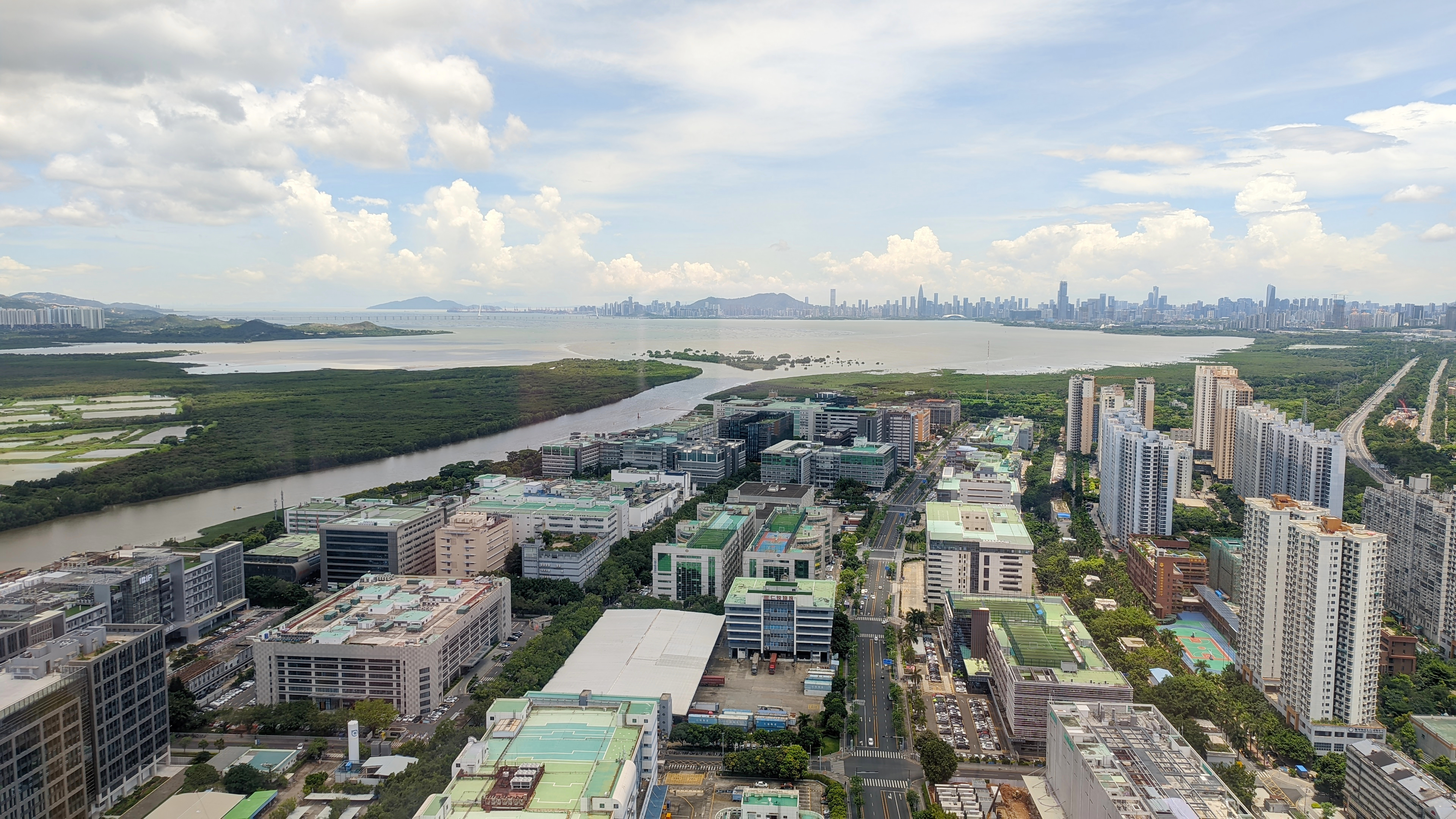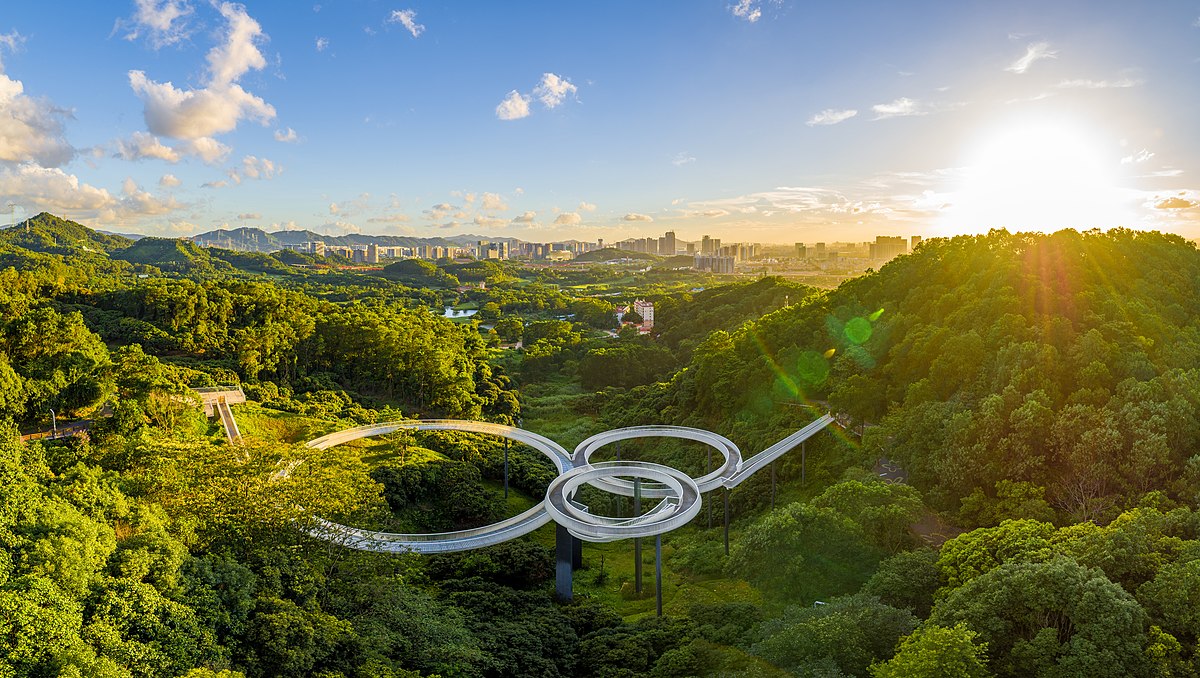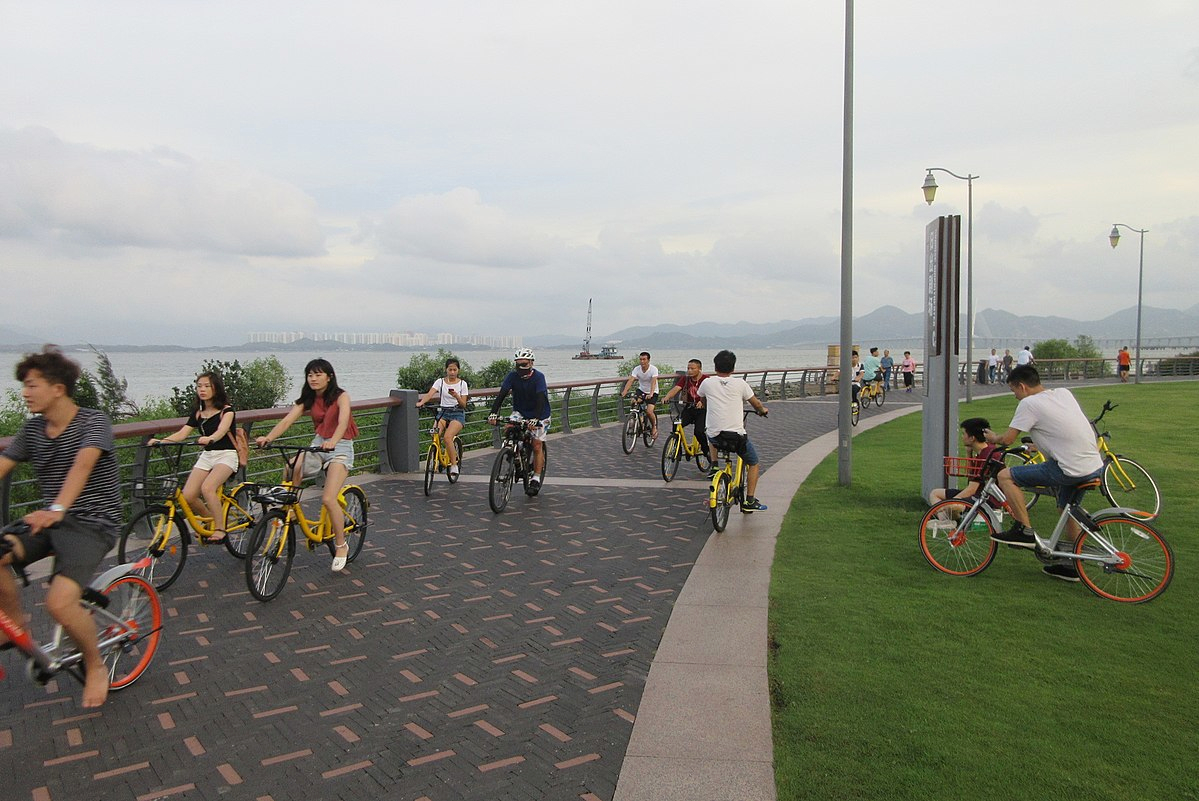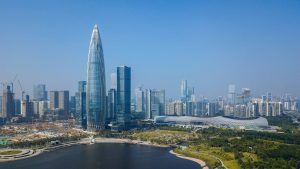In 2017, the city of Shenzhen, China invited foreign teachers like me to visit Futian Mangrove Nature Reserve, on the coast of Shenzhen Bay overlooking Hong Kong. The problem was the reserve did not really exist yet. Walking its trails, we saw that it was mostly dirt dotted with hundreds of tiny seedlings of 16 different species of mangrove trees, the only trees that can survive in saltwater.
It turned out that the city public relations department had gotten ahead of itself. Perhaps it was operating at what China calls “Shenzhen speed,” the pace of the “Instant City,” the fastest-growing city in the history of the world. Since then, the seedlings have grown into a full-blown mangrove forest covering a square kilometer. Some 200 bird species have been spotted there, and it has become a major stop for migratory birds.
These wetlands are part of a Great Green Wall, which now helps guard some of the most densely-developed stretches of Shenzhen’s 260-kilometer coastline from floods. The World Bank says mangrove forests like these reduce both the height and the strength of incoming waves and storm surge, and they are a thousand times cheaper to maintain than seawalls.
What we did not know at the time was that the creation of Futian Mangrove Nature Reserve was part of China’s Sponge Cities Program (SCP). Shenzhen was chosen in 2016 to be one of 14 pilot cities in the second round of sponge cities. The SCP is a visionary attempt to take lemons and make lemonade: to use China’s twin crises of urban flooding and droughts as catalysts for implementing innovative hydroengineering solutions across China.
The Sponge City Philosophy
China wants its cities to be like sponges in that they will be open to absorbing water naturally, rather than keeping water out with pavement and seawalls. Sponge cities will be able to absorb and capture stormwater in one place, where it is a problem, move it, and release it somewhere else where it is useful. This simultaneously reduces floods and increases the city water supply.
The sponge cities concept was invented by Chinese landscape architect and professor Kongjian Yu. He has a Ph.D. from Harvard School of Design and is the founder of Beijing-based landscape design firm Turenscape. When Yu was 10 years old, he almost died in a flood while working in a rice field. This gave him a personal motivation to take on the challenge of flooding.
When he returned from Harvard, Yu was dismayed at the erasure of natural environments he saw as Chinese cities expanded at breakneck speed. Starting in the 2000s, he gave hundreds of lectures, published books, and posted several open letters to the Chinese government suggesting more sustainable nature-based solutions. He argued that many of China’s flood control solutions were imported from Europe and not designed to handle the intense rainfall of China’s monsoon climate regions.
Although Yu’s idea was initially seen as a dream, in 2015, the government picked up his sponge cities concept and turned it into a national initiative. The first round of 16 SCP pilot cities had some of the worst flooding problems in China – including Wuhan, where urbanization had erased all but 30 of its 127 lakes since the 1980s. Each city received over $50 million to invest in planning and infrastructure. Today, after two rounds, there are a total of 30 sponge cities, and China aims to make 80 percent of the urban areas in these cities “sponge-like” by 2030.
The SCP is far from the first comprehensive approach to urban water issues. Low-impact development (LID) emerged in the United States in the 1970s, and Water Sensitive Urban Design (WUSD) and Sustainable Drainage Systems (SUDS) have been implemented in Australia and the U.K., respectively, for decades. These approaches pioneered many techniques now used by sponge cities to increase the storage, infiltration, and purification of water naturally, like retention ponds, permeable surfaces, green roofs, rain gardens, and bioswales (vegetated ditches).
But the SCP covers a wider range of issues than any previous program, including eliminating urban waterlogging, restoring natural ecosystems, and mitigating the urban heat island effect. And sponge cities also help reduce global warming. For example, a Landscape Architecture Foundation analysis found that Shenzhen’s Mangrove Seashore Ecological Park sequesters over 900 tons of carbon each year, equivalent to the annual energy used by 328 U.S. homes.
Three fundamental design principles underlie the SCP. They all involve capturing water at its source, slowing it down, and cleaning it to make it usable. First, as a sponge has many holes that absorb water, a sponge city has many lakes and retention ponds that collect water. Second, as water takes a meandering route through a sponge, sponge cities avoid having water move in straight lines. Instead, they slow the flow of water by diverting it into winding rivers and by surrounding water bodies with wetland vegetation. And third, sponge cities avoid constructing large buildings along waterfronts and instead turn coastlines into natural sinks where water can flow out to the ocean.
Shenzhen Bay Park, adjacent to the mangrove reserve we visited, is a good example of sponge city techniques. Its 13-km coastline is free of large structures; major highways, structures, and residential areas are all behind the park, far from the ocean and safe from floods.

By planting mangrove trees and other wetland vegetation along its 260 km coastline and limiting new construction to areas from the shoreline, Shenzhen’s Sponge Cities programs are helping to protect its population over 12 million from storm surge and sea level rise. Photo from Wikimedia Commons/ Vikama.
Sponge City Techniques
Sponge cities create floodable spaces that can not only survive but thrive during floods. They often contain wetland vegetation, elevated paths, and permeable pavement. For example, the pavement in Shenzhen Bay Park’s wide shoreline path, the Coastal Leisure Belt, allows water to infiltrate slowly and then percolate through a deep bed of gravel underneath, which slows it even more. When the water reaches an impermeable liner at the bottom, gravity leads it down a slight slope into pipes, which allow the city to store the water or direct it out to the ocean.
Greenways are one of sponge cities’ primary tools for controlling the volume of stormwater runoff. Greenways are linear corridors of green space conserved for recreation and ecological protection. They absorb and filter water and connect communities, but they are also crucial to guiding runoff from flood-prone areas to sinks.
Conventional engineering does this with “gray” infrastructure, like pipes, dams, seawalls, and water treatment plants. But according to a 2016 paper by three Chinese landscape architecture professors, gray infrastructure will not be enough in China’s exploding cities: “The conventional drainage infrastructure can hardly deal with frequent inner floods [accompanying China’s] fast urbanization… [T]he low efficiency of drainage pipeline system[s] is a main reason [cause of urban] floods.” To solve this problem, the authors argue that there must be “a spatially connected [runoff] system in the city, to manage stormwater on [a] macro level,” and that because of the area and density of China’s sponge cities, a network of interconnected greenways is the only viable option.
Thanks to the Sponge City Program, Shenzhen now has a high-density greenway network that totals over 2,300 kilometers in length, including green transport corridors, forests, and parks varying in width from under 3 m to over 100 m. For example, greenways have been essential to Shenzhen’s effort to convert one of its most ecologically-dysfunctional urban areas, Fenghuangcheng in Guangming District, into a national model of Sponge City construction.
Fenghuangcheng was an underdeveloped 25 square kilometer area with 64 aging industrial areas and six urban villages, with heavy water pollution and flooding. But since 2016, the area has added 47 km of greenways and 40 hectares of coastal ecological areas, along with permeable parking lots and pathways, a 282 km sewage pipeline network, and new water treatment plants, while also putting strict controls on public sewer usage.

With a glass skywalk 20 m high, Dadingling Forest Park 2021 in Shenzhen’s Guangming district helped transform an aging, highly polluted, and flood-prone industrial area into an urban forest, which absorbs rainwater and carbon dioxide and allows city dwellers to enjoy natural spaces. Photo from Shenzhen city government.
These steps eliminated flooding in six areas, eliminated pollution in seven river branches, and reduced the urban heat island effect by dropping Fenghuangcheng’s average high temperature by 1.9 degrees C in just two years, from 39.7 degrees C in 2016 to 37.8 degrees C in 2018.
Greenways are also at the heart of two lakeside Sponge City parks that opened in Shenzhen in 2017, both of which have become instant attractions: Talent Park and Xiangmi (Honey Lake) Park. Talent Park along Shenzhen Bay is a greenway loop of forest, trails, and open green spaces around a coastal lake. It acts as the sink for an extensive drainage canal network, which collects runoff from the ultra-dense Houhai neighborhood just inland. Talent Park is filled with art and displays about talented people from Shenzhen, and its designer, Zhu Jie, incorporated diverse plants that each bloom in a different one of the four seasons, so the park’s appearance changes throughout the year.
Xiangmi Park was created farther inland on the grounds of a former agricultural research center, which for over three decades had prevented urbanization from encroaching on its green space. The new park kept a lychee tree orchard, fish ponds, and palm trees that the agricultural center had preserved, and it added a new 6 km greenway with permeable trails, retention ponds, flower gardens, urban forests, and the Xiangmi Park Science Library, which is connected to the park by an elevated walkway through the treetops. Shenzhen calls Xiangmi Park its “green lungs.”
Twin Crises: Floods and Droughts
Every one of China’s ten largest cities has had neighborhoods submerged in floodwater in recent years. And this year saw China’s worst drought in decades. Shenzhen suffers from both floods and droughts. It is a tropical coastal city with a monsoon climate, which brings torrential rains every summer and near-desert level precipitation in winter. A study in Nature Climate Change ranked Shenzhen among the top 10 world cities in potential future losses due to floods.
In other parts of Guangdong province, flooding “surpassed historical records” in the summer of 2022, according to China’s ministry of water resources. Photos from Guangdong showed residents trapped on their roofs or paddling out of town in emergency rafts. In 2019, 11 dredging workers were killed in Shenzhen when river floods swept them away.
The cause of China’s urban flooding problem is partly ultra-rapid urban growth. Urbanization typically creates vast new impervious paved surfaces, which cause stormwater to build up on the surface as runoff instead of infiltrating the ground. A 2013 study by Chinese geographers found that China’s total area of impervious surfaces increased by 53 percent from 2000 to 2008. China’s flood problem is also partly due to ill-planned construction, sometimes in known flood hazard zones, amid the rush to create buildings and infrastructure to accommodate the world’s largest rural-to-urban migration over the past two decades.

Filled with floodable greenways and bikeways made of permeable pavement, Shenzhen Bay Park puts a natural buffer between Shenzhen’s dense downtown neighborhoods and the sea while allowing thousands every day to enjoy views along 13 km of Shenzhen’s coastline. Photo from Wikimedia Commons/Ahyausharsae
The Sponge City Program initiatives underway in Shenzhen are only a start. The city still has massive issues with erosion, flooding, and water shortages. But the hydroengineering solutions mentioned above are helping China’s Instant City create flood protections to catch up with its rapid growth.
In the big picture, tropical coastal cities like Shenzhen – such as Bangkok, Manila, Mumbai, Dhaka, Ho Chi Minh City, and Guayaquil – are projected to experience the greatest increases in rainfall with global warming. Dhaka, Chennai, Mumbai, Kochi, and other major cities are currently studying ways to adapt the sponge cities approach to their environments. And in the future, China aims to market sponge city projects to its foreign partners in the Belt and Road Initiative, many of whom are developing countries with exploding urban populations facing similar hydroengineering challenges.
Shenzhen has a long way to go to manage flooding. But it has advantages over other Chinese cities in technology, investment funding, and can-do spirit, which are allowing it to put sponge city principles into action at its trademark pace. As it does, Shenzhen is once again playing the role of China’s living urban laboratory, where the future of tropical coastal cities is on display.

































